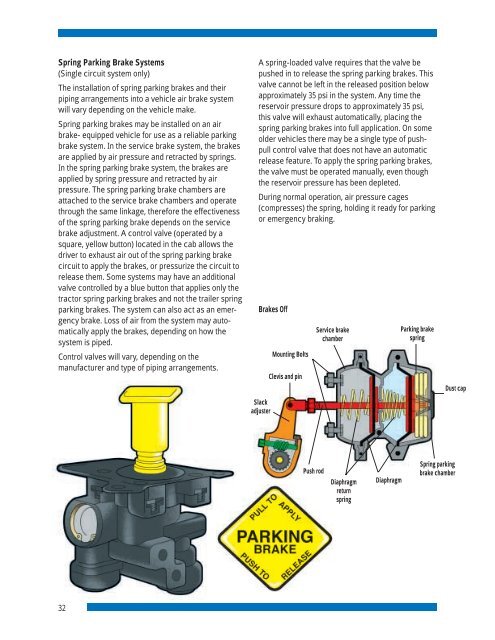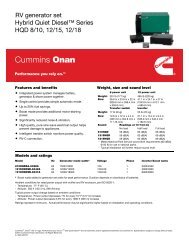Air Brake Manual
Air Brake Manual
Air Brake Manual
Create successful ePaper yourself
Turn your PDF publications into a flip-book with our unique Google optimized e-Paper software.
Spring Parking <strong>Brake</strong> Systems<br />
(Single circuit system only)<br />
The installation of spring parking brakes and their<br />
piping arrangements into a vehicle air brake system<br />
will vary depending on the vehicle make.<br />
Spring parking brakes may be installed on an air<br />
brake- equipped vehicle for use as a reliable parking<br />
brake system. In the service brake system, the brakes<br />
are applied by air pressure and retracted by springs.<br />
In the spring parking brake system, the brakes are<br />
applied by spring pressure and retracted by air<br />
pressure. The spring parking brake chambers are<br />
attached to the service brake chambers and operate<br />
through the same linkage, therefore the effectiveness<br />
of the spring parking brake depends on the service<br />
brake adjustment. A control valve (operated by a<br />
square, yellow button) located in the cab allows the<br />
driver to exhaust air out of the spring parking brake<br />
circuit to apply the brakes, or pressurize the circuit to<br />
release them. Some systems may have an additional<br />
valve controlled by a blue button that applies only the<br />
tractor spring parking brakes and not the trailer spring<br />
parking brakes. The system can also act as an emergency<br />
brake. Loss of air from the system may automatically<br />
apply the brakes, depending on how the<br />
system is piped.<br />
Control valves will vary, depending on the<br />
manufacturer and type of piping arrangements.<br />
A spring-loaded valve requires that the valve be<br />
pushed in to release the spring parking brakes. This<br />
valve cannot be left in the released position below<br />
approximately 35 psi in the system. Any time the<br />
reservoir pressure drops to approximately 35 psi,<br />
this valve will exhaust automatically, placing the<br />
spring parking brakes into full application. On some<br />
older vehicles there may be a single type of pushpull<br />
control valve that does not have an automatic<br />
release feature. To apply the spring parking brakes,<br />
the valve must be operated manually, even though<br />
the reservoir pressure has been depleted.<br />
During normal operation, air pressure cages<br />
(compresses) the spring, holding it ready for parking<br />
or emergency braking.<br />
<strong>Brake</strong>s Off<br />
Slack<br />
adjuster<br />
Mounting Bolts<br />
Clevis and pin<br />
Service brake<br />
chamber<br />
Parking brake<br />
spring<br />
Dust cap<br />
Push rod<br />
Diaphragm<br />
return<br />
spring<br />
Diaphragm<br />
Spring parking<br />
brake chamber<br />
32




